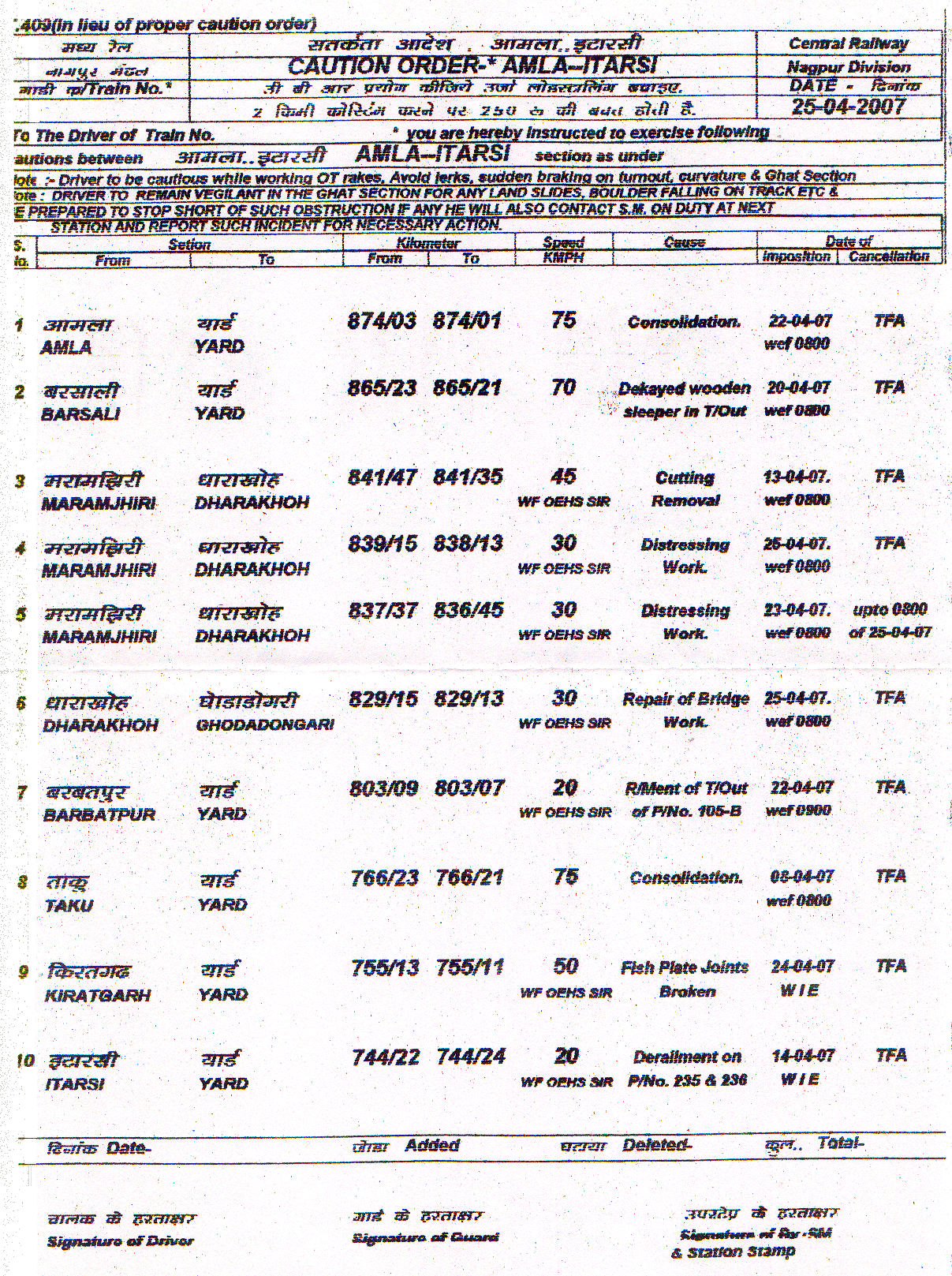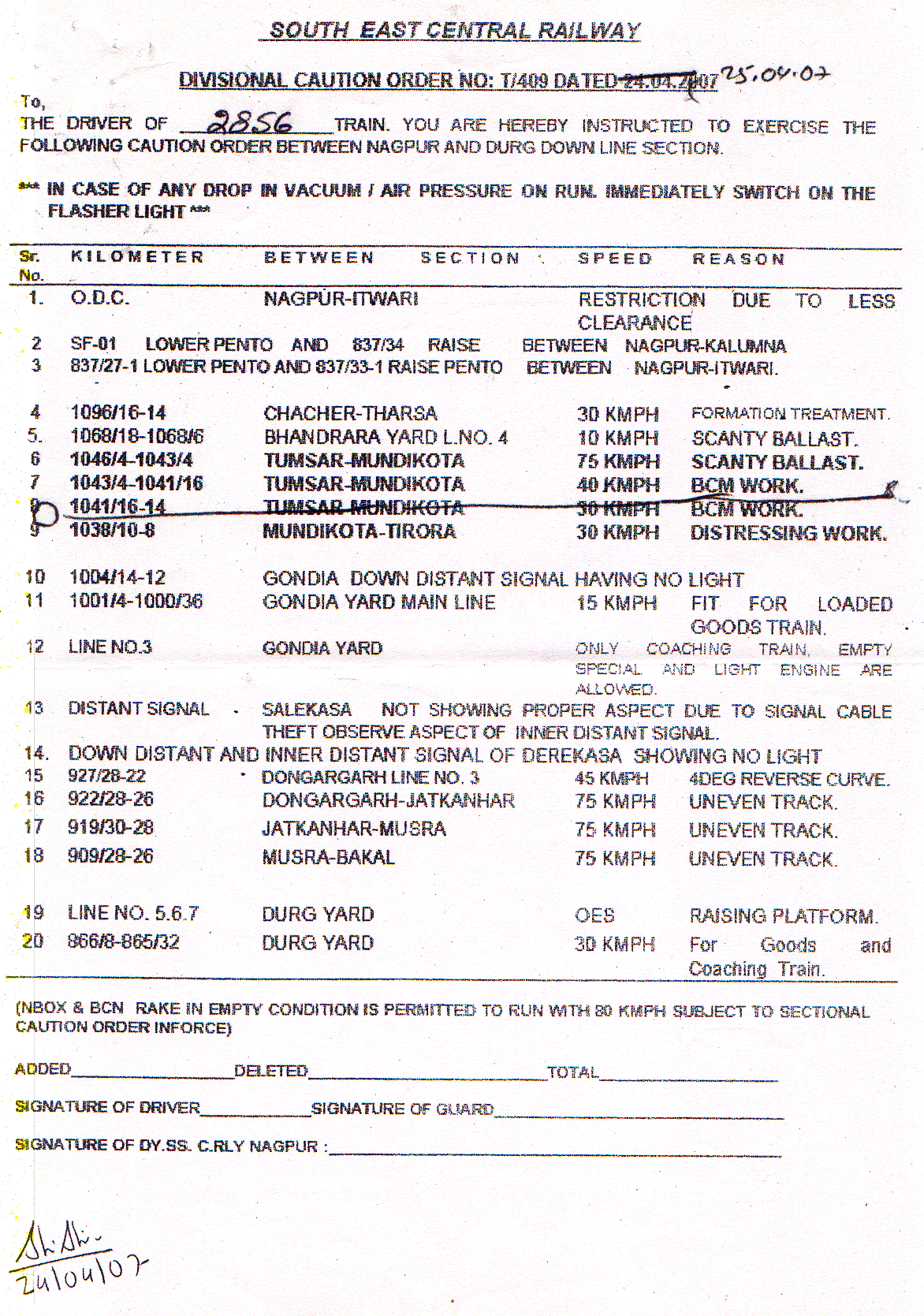Caution Orders
by Ravindra Bhalerao, 2008
The primary document which provides a train driver with details regarding where he is required to slow down his train during the run, the speed at which he has to drive, and so on is called a "caution order". A caution order will tell a driver the names of the stations between which work is being undertaken, the kilometerage of the spot, the nature of the work being done, and, most important, the speed at which he must drive.
Caution orders are generally prepared by station masters of certain nominated stations called 'notice stations'. For example, the Howrah-Bombay Mail on arriving at Nagpur would receive a caution order which lists speed restrictions on the way upto Badnera. On arrival at Badnera, which is again a notice station, the driver receives a fresh caution order that is applicable upto Bhusaval, and so on.
The speed restrictions mentioned in a caution order fall into two categories. Permanent speed restrictions which apply all the year round, refer to locations that have an inherent feature making it necessary for a train to slow down at the spot. A blind curve, a bridge that is weak, or a ghat section whose geological structure is known to be unsuitable for high speeds are examples of locations where a permanent speed restriction has to be imposed. On the other hand, if the track or the formation develops a defect somewhere along the route, trains will need to slow down but only as long as repair work is in progress. In such a case, a 'temporary speed restriction' has to be brought into force.
Have you ever been mystified by a shrill whistle coming from the lineside when your train is travelling at speed? This is the patrolman on duty and his whistle is meant to reassure the train crew that he is around and that things are indeed normal.
Railway track is monitored each day by patrolmen, also known as gangmen, whose job it is to walk along the route looking for signs of missing fishplates, broken rails and welds, rails fractures, and other defects occurring in the ballast or formation. To make a long story short, a gangman armed with equipment consisting of a hammer, detonators and red and green flags begins his inspection walk from a station till he meets his colleague who is approaching in his direction from the next station ahead. When the two meet, they exchange their patrol books before returning to their respective stations. The patrol books have to be signed by the station masters at either end, and the process of exchange ensures that the men walked upto their common meeting point, thereby leaving no portion of the track unattended.
Should a patrolman find anything wrong, he has to do everything in his power (using the red flags or detonators he is carrying) to halt an approaching train whilst his colleague rushes to the nearest station and apprises the station master of the situation. The station master in turn immediately phones the section controller informing him of the development.
On receiving this message, one of the first things the controller does is to inform station masters in the vicinity of the area asking them to halt oncoming trains till such time as further information is received. This step is of the utmost importance, for till now no one knows about the precise conditions at the spot.
Besides giving an alert to adjoining station masters, the section controller also rings up the Permanent Way Inspector. The PWI, as he is known, is an inspecting official holding charge of the permanent way and is a civil engineer by profession, and when he receives a call from control, he picks up his gangmen and rushes to the spot, often by a fast express.
Finally someone who is knowledgeable enough has arrived at the spot. An inspection of the place will reveal to the PWI the nature of the trouble, the equipment and workforce needed to put things right, the likely duration of the work, and most important, how much a train should slow down while negotiating the spot. If the work is likely to last for a week or more, he fills up what is known as a 'caution order memo' giving details, and has it sent to the nearest station master through a gangman. This document is duly signed by the station master who relays the contents to the control office.
The controller has now a full picture of what is happening at the site of repair. He will now contact stations along the line where trains were halted earlier under his instruction, asking station masters to allow these trains to proceed under a 'temporary caution order' which instructs the driver to slow down at the location concerned to a speed recommended by the PWI.
In the meantime, the station which received the PWI's caution order memo in the first place has also relayed the contents to the notice stations on either side. The station master of the notice station is now in a position to include details of the speed restriction concerned in the regular caution orders issued by him.
Examples of two caution orders will be found below, both issued in April 2007, one applying to the stretch from Nagpur to Durg, the other for the Amla-Itarsi section of Central Railway. It is interesting to note the reasons quoted in these documents beside each speed restriction : these range from bridge repairs and derailments to rail dolly working and even signals not showing the proper aspect due to signal cable theft.


